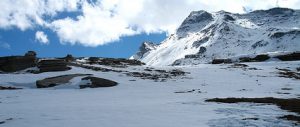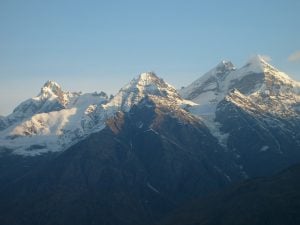[Download Kenneth Hewitt’s full report here]
Glaciers are quite sensitive to climate change and, recently, there have been many reports of major changes in the Himalaya and other parts of High Asia; mostly of glaciers retreating fast. Impacts of a range of glacier hazards, and on the reliability of water resources, are of concern at local, national and transnational scales. However, there is also a growing recognition that glacial conditions in the region are very diverse, and so are their responses to climate change.
There are some very different implications in different societal contexts, not least in relation to rapid socio-economic changes, water resource projects and security crises. The latter are often more urgent or immediate problems that disrupt or undermine peoples’ capacities to adapt to environmental change. Such complexities are the focus of this article. The reality of climate change is not questioned, but some recent oversimplifications are, and claims about a narrow range of glacier hazards. In particular, unresolved problems of understanding high altitude glaciers and climate are emphasised, and the inadequacies of available information and monitoring. Recent evidence of glacier advances in the Karakoram Himalaya, and the author’s work there, illustrate many of these complexities.
Ablation zone conditions where annual ice losses are high: dust, dirt and scattered debris areas on Kaberi-Kondus Glacier, late June, at 4,000 metres above sea level. (Photograph/Kenneth Hewitt 1998)
Globally, most glaciers are reported to be diminishing more or less rapidly. Reports of “disappearing glaciers” have come from many parts of High Asia. However, this is not the case in the upper Indus and upper Yarkand River basins. Here, the glaciers have been holding their own for several decades and recently, in the Karakoram Himalaya, many have started thickening and advancing. Not only is this opposite to the broader picture for Eurasian glaciers, but also to what had been happening to Karakoram glaciers. Through most of the twentieth century they too diminished and retreated. There is no question that today’s behaviour is a regionally distinct response to climate change. It may sound like good news, given the dominant lament for the loss of glaciers, but that too would be misleading. Advancing glaciers bring dangers as well.
The surge of the Maedan tributary of Panmah Glacier. Notice severe crevassing of ice. (Photograph/Kenneth Hewitt, June 2005)
Of immediate concern are a number of glaciers on the Indus and Yarkand Rivers, whose past advances gave rise to large ice dams and catastrophic outburst floods. In the longer term, existing and planned water resource uses, dependent on glacier-fed streams or at risk from glacial floods and sedimentation, are of major concern. However, the largest challenges stem from inadequate information and monitoring, and limited scientific understanding of these high elevation glaciers. Misleading or exaggerated reports based on assumption rather than evidence are also a problem. Some high profile reports have suggested that the Indus basin is in imminent danger of losing its glaciers. Glacier hazards, notably “dangerous lakes” associated with retreating ice in other regions, have been assumed to be equally present in the Karakoram. The reports are simply wrong in this case.
Meanwhile, if the main trend in most of High Asia does seem to be glacier retreat, various lines of evidence show that it is occurring at very different rates in different mountain ranges, even within the same mountains. A 2006 survey of 5,020 glaciers in the mountains of western China and the Tibetan Plateau found widely differing rates of reduction. It also found 894 glaciers, about 18%, have advanced in recent decades. The jury is still out on a 2009 report from India [pdf], which questions the scale and reality of the extreme rates of retreat formerly reported for the Himalayas, and projections based on them.
None of this is to suggest that climate change is not a serious issue in the Karakoram. In every valley of the region farmers tell me the winters have grown shorter in the past couple of decades, there is less snow and more rain. They report an increase in windstorms and rain during summer. Formerly, clear, sunny weather in autumn was reliable and perfect for drying grain, fruit and winter fodder, and for post-harvest chores around the villages. Not any more. They report increasing problems with damp and mildew from insufficient drying days. Rain and wind threaten the harvest and damage buildings. These are, in fact, more immediate hazards for the mountain communities than anything that may be happening to the glaciers. This refers to the inhabited areas at lower elevations, where more, and more severe, rainstorms have been reported in recent years, notably a disastrous storm on September 9, 1992. It triggered rockfalls and debris flows that damaged many villages, closed most roads and stranded tourists. Again, advancing glaciers are also a response to climate change – and are not necessarily good news.
Although there have been reports and discussions of Karakoram glaciers since the mid-nineteenth century, they have been patchy in space and time and of varying quality. The glaciers are not, and have never been, consistently monitored. Few glaciers anywhere in the inner Asian mountains meet the criteria of the World Glacier Monitoring Service, and hence have not been tracked by it. The cries of concern for these glaciers should at least highlight the need for more reliable data and a better grasp of climate-glacier interactions in the world’s highest mountains.
Panmah Glacier accumulation zone, showing surrounding rock walls up to 2,500 metres high around the Latok Peaks, June 2005. (Photograph/Kenneth Hewitt, 2005)
The glacier cover of High Asia exceeds 110,000 square kilometres, the number of identifiable glaciers more than 50,000. There are major concentrations in about a dozen mountain ranges, forming watersheds of all the major rivers of the central, south and south-east Asian mainland. The Upper Indus and Yarkand basins have around 21,000 square kilometres of glaciers, the larger fraction in the Greater Karakoram, or about 16,500 square kilometres. Most of the biggest valley glaciers outside polar regions are found here. While there are more than 5,000 individual glaciers, just 12 make up almost half the ice cover. Melt waters from glacier basins comprise more than 40% of the average annual flows of the Indus and the Yarkand, with a potential to affect the lives of some millions of people downstream. While there was a roughly 10% reduction of the Karakoram ice cover in the first 60 years of the twentieth century, no significant reduction has occurred in recent decades and, as noted, many glaciers are undergoing advances.
One must qualify the notion that threats only arise from “disappearing” glaciers or in proportion to the rate of reduction. This is certainly a cause for concern, in itself or in what it implies about humanly induced atmospheric changes. But growing glaciers are not necessarily benign. In most glacierised mountains, certainly the Karakoram Himalaya, the worst consequences experienced in recent history came with the enlarged ice cover of the Little Ice Age: a period of several centuries, ending just over 100 years ago, when glaciers grew throughout the northern hemisphere. From those events come most of the stories and fears about glaciers recalled in Himalayan towns and villages. The considerable reduction of the glaciers observed between about 1910 and the 1960s was, in effect, removing ice stored in the Little Ice Age, a process that is not yet complete. Today’s glaciers are larger than a few centuries ago. Meanwhile, the evidence of advances in the Karakoram not only indicates a different response here to changing climate. It raises the prospect of a return to the hazards of advancing ice not seen since the Little Ice Age.
NEXT: Factors underlying regional variance
Kenneth Hewitt is professor emeritus in geography and environmental studies and research associate at the Cold Regions Research Centre at Wilfrid Laurier University in Ontario, Canada.
Homepage image by Kenneth Hewitt shows the upper Chiring-Panmah Glacier in 2005 and illustrates the prevalence of steep rock walls in the upper parts of these glacier basins.
[Download Kenneth Hewitt’s full report here]



